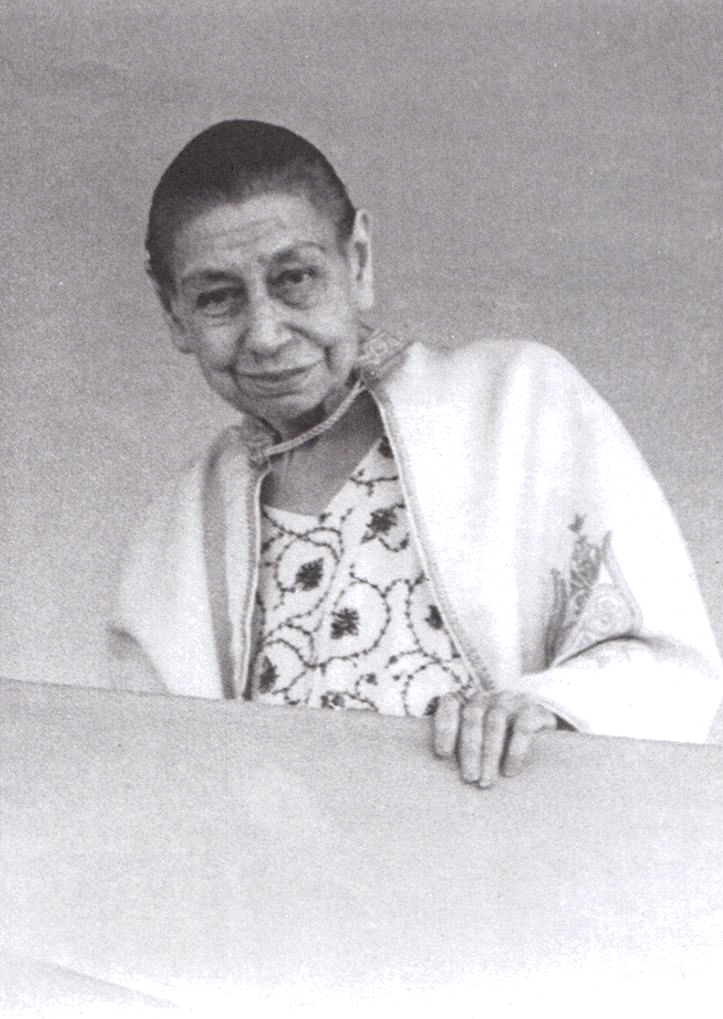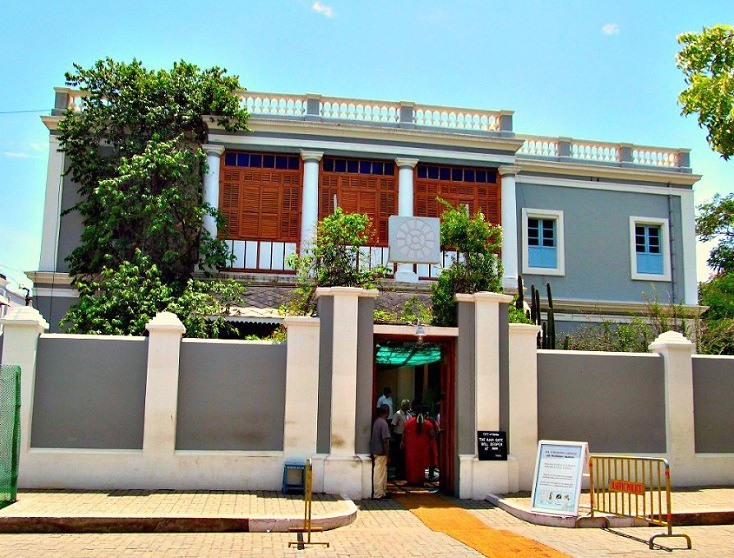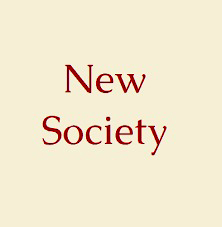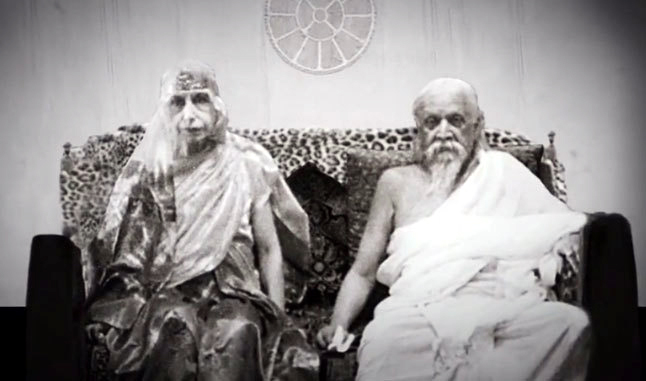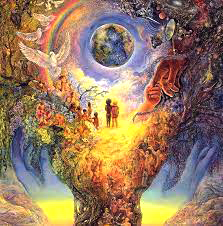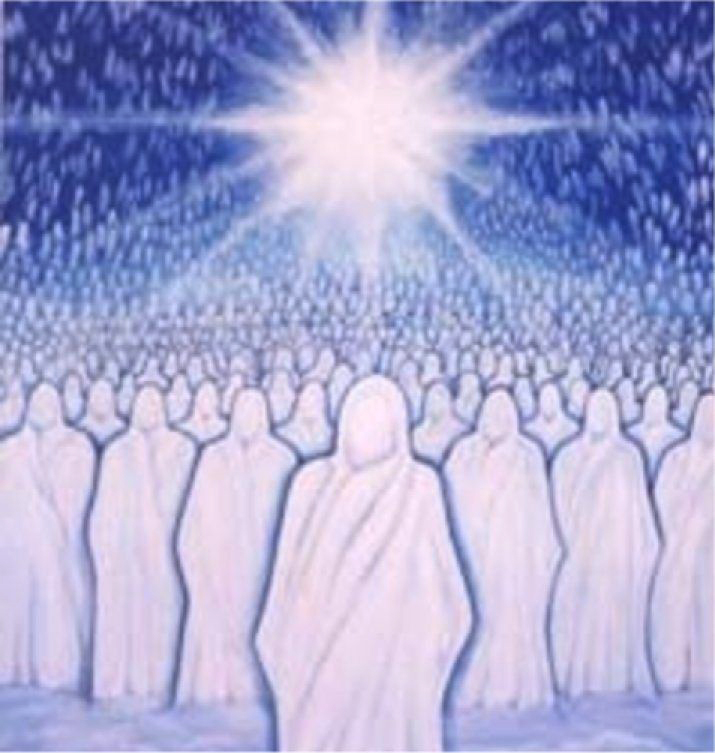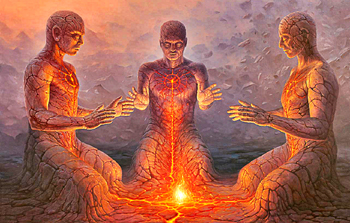Social health
Towards a Spiritualised Society
Abstract
Human beings are not just social animals but a unique species that tries to make their individual and collective existence more meaningful. After the first preoccupation with survival is over, man turns his quest towards higher things. This higher pursuit has given birth to yoga and spirituality. But generally spirituality is considered as a means for attaining individual freedom. However, there is a possibility of collective reorganisation of mankind as the spiritual evolution carries us further. This article discusses the possibilities of a spiritualised society in the future.
Aspiration towards the future
Social health is generally measured by outer indicators such as wealth, education, healthcare, as also crime rates in a group life. There are also psychological indicators such as personal and community satisfaction and happiness. These are no doubt required but these alone cannot be the measure of the real worth of a society. There are other inner and deeper aspects of a collective life that need to be considered, other forms of action than the mere outer ones, that need to be reckoned in forming an ideal society. There is yet another factor that often lies hidden in the inmost self, where its secret aspirations are shaping its future life.
This factor of aspiration, of what we want to be rather than what we are, is a faith and will to be in an individual as well as group life. It indicates the extent to which a society has evolved or will evolve in times to come. In other words, instead of seeing social health as something static, we can see it as something moving and dynamic. In an individual too, his present state, both physical and psychological do not really indicate the future that is going to unfold because while the present is the result of his past energies released through thoughts and feelings and actions, the future is not necessarily the extension and prolongation of the present. That may be so if the person is driven by habit alone. Thus, a society that may look like a dream-world today when seen by outer eyes and assessed on external parameters may well be preparing its decline in times to come because its dreams are limited to amassing wealth and outer comforts, increasing the means for pleasures of the body, often at the expense of the inner life. Such a society is asuric and like ancient golden Lanka and Atlantis preparing for its doom. On the other hand a society, even in a subject nation, with noble and high aspirations is destined to throw away the shackles of bondage and rise like the phoenix bird.
But there is in man a secret something, an inmost soul so to say, that declares itself through conscious aspiration and faith in things that are not and yet can be. In every society, there are some forerunners who harbour this aspiration and, regardless of the degree of their success, they leave a stamp of their thought, open a door of possibility through the effort of their will, knead and heave the mass by the power of their heart, as a living dynamo, sending tremendous currents through the human race, and most of all, become living examples for the race. Such were the great and luminous ones, the Vedic seers, SSrıi Rama, SSrıi Krrssna, the countless saints and sages of the Middle Ages, the mighty Buddha and Shankara, and in our more recent times Sri Ramakrishna and Swami Vivekananda. Summing them up all as well as extending the limits of what these luminous beings brought to earth to limitless horizons of possibility is Sri Aurobindo. He has planted a new aspiration in the human race and, through his luminous words and his own example, shown the way forward for the human individual and the human society.
This new life is spreading fast as a growing aspiration, a faith and a will to be in the spearheads of humanity. They are everywhere, in all countries so to speak. They are the true spearheads of a silent social revolution that is taking place behind the surfaces of mankind, like the chick is quietly being formed within the egg even though nothing seems visible on the surface. Or like the tree silently taking roots in the soil below the visible surface. The farmer knows what is happening since it is he who has prepared the soil, planted the tree or sown the seed, watered it with all the care that is needed, provided it the right climate and the space to grow. The ordinary man looking from the outside may not know it, but the chick is growing its wings within the shell, ready to fly. This ground where the seeds were sown and the branch of heaven transplanted to human soil is what we know today as the Sri Aurobindo Ashram, Pondicherry. The dream of a New World was planted here as we find in the following words of the Mother:
“There should be somewhere on earth a place which no nation could claim as its own, where all human beings of goodwill who have a sincere aspiration could live freely as citizens of the world and obey one single authority, that of the supreme truth; a place of peace, concord and harmony where all the fighting instincts of man would be used exclusively to conquer the causes of his sufferings and miseries, to surmount this weaknesses and ignorance, to triumph over his limitations and incapacities; a place where the needs of the spirit and the concern for progress would take precedence over the satisfaction of desires and passions, the search for pleasure and material enjoyment. In this place, children would be able to grow and develop integrally without losing contact with their souls; education would be given not for passing examinations or obtaining certificates and posts but to enrich existing faculties and bring forth new ones. In this place, titles and positions would be replaced by opportunities to serve and organise; the bodily needs of each one would be equally provided for, and intellectual, moral and spiritual superiority would be expressed in the general organisation not by an increase in the pleasures and powers of life but by increased duties and responsibilities. Beauty in all its artistic forms, painting, sculpture, music, literature, would be equally accessible to all; the ability to share in the joy it brings would be limited only by the capacities of each one and not by social or financial position. For in this ideal place money would no longer be the sovereign lord; individual worth would have a far greater importance than that of material wealth and social standing. There, work would not be a way to earn one’s living but a way to express oneself and to develop one’s capacities and possibilities while being of service to the community as a whole, which, for its own part, would provide for each individual’s subsistence and sphere of action. In short, it would be a place where human relationships, which are normally based almost exclusively on competition and strife, would be replaced by relationships of emulation in doing well, of collaboration and real brotherhood.
The earth is certainly not ready to realise such an ideal, for mankind does not yet possess sufficient knowledge to understand and adopt neither does it posess the conscious force that is indispensable in order to execute it; that is why I call it a dream.
And yet this dream is in the course of becoming a reality; that is what we are striving for in Sri Aurobindo’s Ashram, on a very small scale, in proportion to our limited means. The realisation is certainly far from perfect, but it is progressive; little by little we are advancing towards our goal which we hope we may one day be able to present to the world as a practical and effective way to emerge from the present chaos, to be born into a new life that is more harmonious and true (1).”
Matrix of the New Society
This dream contains the blueprint of the spiritualised society of the future. It had started turning into a reality, an infant reality when the Supramental Consciousness manifested on 29th February, 1956. The infant had to be now fed on the right kind of nourishment. Sri Aurobindo Society, Auroville and other branches began to grow to provide the right kind of atmosphere for this new humanity, yet in its infancy, to grow and evolve under the pressure of the New Consciousness. It is natural that the impact of the New Consciousness is bound to draw more and more human beings, not only in terms of numbers but also in terms of types and standing at different degrees and scales of human layers, formed so far through the evolutionary forces that operate through nature. All of this cannot be undertaken at the Ashram because of the sheer limitations of physical space so the Mother extended Herself everywhere, connecting and linking all who so aspired as points of golden light woven together through golden threads and joined through her heart and the golden ties of the New Consciousness. A larger group life started preparing itself soon after the supramental manifestation as revealed through her conversations soon after.
“This is the condition of the earth, and it is not very bright. But for us one possibility remains — I have spoken about it to you several times already — even if, outside, things are deteriorating completely and the catastrophe cannot possibly be avoided, there remains for us, I mean those for whom the supramental life is not a vain dream, those who have faith in its reality and the aspiration to realise it — I don’t necessarily mean those who have gathered here in Pondicherry, in the Ashram, but those who have as a link between them the knowledge Sri Aurobindo has given and the will to live according to that knowledge — there remains for them the possibility of intensifying their aspiration, their will, their effort, to gather their energies together and shorten the time for the realisation. There remains for them the possibility of working this miracle — individually and to a small extent collectively — of conquering space, duration, the time needed for this realisation; of replacing time by intensity of effort and going fast enough and far enough in the realisation to liberate themselves from the consequences of the present condition of the world; of making such a concentration of force, strength, light, truth, that by this very realisation they can be above these consequences and secure against them, enjoy the protection bestowed by the Light and Truth, by Purity — the divine Purity through the inner transformation — and that the storm may pass over the world without being able to destroy thisgreat hope of the near future; that the tempest may not sweep away this beginning of realisation.
Instead of falling asleep in an easy quietude and lettingthings happen according to their own rhythm, if one strains to the utmost one’s will, ardour, aspiration and springs up into the light, then one can hold one’s head higher; one can have, in a higher region of consciousness, enough room to live, to breathe, to grow and develop above the passing cyclone.
This is possible. In a very small way, this was already done during the last war, when Sri Aurobindo was here. It can be done again. But one must want it and each one must do his own work as sincerely and completely as he can (2).”
She reminds us that true unity is not dependent upon geographical space or on the language we speak and dress we wear or customs we follow. These are but outer things. They may give us a semblance of unity like the orange that appears as one piece but is divided inside. True unity is like the musk-melon that looks like different pieces, joined together to create the fruit, but is in fact a single whole within. This unity can only be created by a joining-off of inner efforts, a unity built through a common aspiration, spreading naturally from within outwards. It is at first a unity of souls that come together in a common aspiration. The outer unity should be a natural consequence and not vice versa. It is also important to know that social evolution does not proceed along a straight line. Like with the individual, human groups also move along spirals wherein there seems to be a fall of the general level at times but the rise that inevitably would follow if the core aspiration and faith are kept intact will be higher. Each descent prepares for a greater ascent. The Mother explains:
“For a very long time the Ashram was only a gathering of individuals, each one representing something, but as an individual and without any collective organisation. They were like separate pawns on a chess-board — united only in appearance — or rather by the purely superficial fact of living together in the same place and having a few habits in common — not even very many, only a few. Each one progressed — or didn’t progress — according to his own capacity and with a minimum of relations with others. So, in accordance with the value of the individuals constituting this odd assemblage, one could say that there was a general value, but a very nebulous one, with no collective reality.
This lasted a very long time — very long. And it is only quite recently that the need for a collective reality began to appear — which is not necessarily limited to the Ashram but embraces all who have declared themselves — I don’t mean materially but in their consciousness — to be disciples of Sri Aurobindo and have tried to live his teaching. Among all of them, and more strongly since the manifestation of the Supramental Consciousness and Force, there has awakened the necessity for a true communal life, which would not be based only on purely material circumstances but would represent a deeper truth, and be the beginning of what Sri Aurobindo calls a supramental or gnostic community.... He has said, of course, that, for this, the individuals constituting this collectivity should themselves have this supramental consciousness; but even without attaining an individual perfection — even while very far from it — there was at the same time an inner effort to create this “collective individuality”, so to speak.
The need for a real union, a deeper bond has been felt and the effort has been directed towards that realisation. This has caused some... disturbance, for the tendency was formerly so individualistic that certain habits have been upset I don’t mean materially, for things are not very different from what they were, but in a somewhat deeper consciousness. And above all — that is the point I want to emphasise — this has created a certain inner interdependence which has naturally lowered the individual level — a little — except for those who had already attained an inner realisation strong enough to be able to resist this movement of what I might call “levelling”. And this is what gives the impression that the general level has fallen, which is not correct. The general level is on a higher plane than it formerly was, but the individual level has dropped in many cases, and individuals who were capable of one realisation or another have felt, without understanding why, weighed down by a load they did not have to carry before, which is the result of this interdependence. It is just a temporary effect which, on the other hand, will lead to an improvement, a very tangible general progress.
Of course, if each individual was conscious, if instead of yielding to this kind of levelling effect, he resisted it in order to transform, transmute, uplift the elements, influences, currents he receives from the group, then the whole would rise up into a higher consciousness far ahead of where it was before….. There is no other reason for this kind of apparent fall which, in fact, is not one. It is the spiral movement of progress which makes it necessary to move away from a certain realisation in order to make it not only vaster but also higher. If everyone collaborates consciously and with goodwill, it will go much faster.
It was an imperative necessity if one wanted this Ashram life to be viable. Everything that does not progress necessarily declines and perishes, and for the Ashram to last it had to make progress in its consciousness and become a living entity. There. We are rather far away in the spiral from the line of realisation we had some years ago, but we shall come back to it on a higher level (3).”
Blueprint for the future
What remains now is for us to move as a collective body remembering that each of us is like a unit in the great unity, or like a cell within the larger body having an impact upon each other. If one of us falls back, the whole body suffers its advance. On the other hand, if one of us progresses then the whole is pulled forward even if by an inch. This is how the collective yoga operates in an unseen yet tangible manner. Thus each takes or rather assumes his full responsibility for the whole whereas the whole helps each to grow and progress by creating a matrix in which those with a new consciousness can breathe and grow.
A collective life therefore has started forming. It grows as the number of individuals are organically brought in. Each brings his or her own challenges, difficulties, problems but also new and unique possibilities. Each becomes a part of the whole and carries within himself the whole. But this matrix that has formed right beside the old world matrix is not cut off from the old. It receives the impacts of the old world and sends healing and harmonising signals out of itself into the old. Thus slowly, through percolation and permeation, the whole earth draws together into a single plan.
What that plan is, what are the details of this new life have also been elaborately described by Sri Aurobindo with which we can close for the moment.
“A spiritualised society would live like its spiritual individuals, not in the ego, but in the spirit, not as the collective ego, but as the collective soul. This freedom from the egoistic standpoint would be its first and most prominent characteristic. But the elimination of egoism would not be brought about, as it is now proposed to bring it about, by persuading or forcing the individual to immolate his personal will and aspirations and his precious and hard-won individuality to the collective will, aims and egoism of the society, driving him like a victim of ancient sacrifice to slay his soul on the altar of that huge and shapeless idol. For that would be only the sacrifice of the smaller to the larger egoism, larger only in bulk, not necessarily greater in quality or wider or nobler, since a collective egoism, result of the united egoisms of all, is as little a god to be worshipped, as flawed and often an uglier and more barbarous fetish than the egoism of the individual. What the spiritual man seeks is to find by the loss of the ego the self which is one in all and perfect and complete in each and by living in that to grow into the image of its perfection, — individually, be it noted, though with an all-embracing universality of his nature and its conscious circumference….
Therefore a society which was even initially spiritualised would make the revealing and finding of the divine Self in man the supreme, even the guiding aim of all its activities, its education, its knowledge, its science, its ethics, its art, its economical and political structure. As it was to some imperfect extent in the ancient Vedic times with the cultural education of the higher classes, so it would be then with all education. It would embrace all knowledge in its scope, but would make the whole trend and aim and the permeating spirit not mere worldly efficiency, though that efficiency would not be neglected, but this self-developing and self-finding and all else as its powers. It would pursue the physical and psychic sciences not in order merely to know the world and Nature in her processes and to use them for material human ends, but still more to know through and in and under and over all things the Divine in the world and the ways of the Spirit in its masks and behind them. It would make it the aim of ethics not to establish a rule of action whether supplementary to the social law or partially corrective of it, the social law that is after all only the rule, often clumsy and ignorant, of the biped pack, the human herd, but to develop the divine nature in thehuman being. It would make it the aim of art not merely to present images of the subjective and objective world, but to see them with the significant and creative vision that goes behind their appearances and to reveal the Truth and Beauty of which things visible to us and invisible are the forms, the masks or the symbols and significant figures.
A spiritualised society would treat in its sociology the individual, from the saint to the criminal, not as units of a social problem to be passed through some skilfully devised machinery and either flattened into the social mould or crushed out of it, but as souls suffering and entangled in a net and to be rescued, souls growing and to be encouraged to grow, souls grown and from whom help and power can be drawn by the lesser spirits who are not yet adult. The aim of its economics would be not to create a huge engine of production, whether of the competitive or the cooperative kind, but to give to men — not only to some but to all men each in his highest possible measure — the joyof work according to their own nature and free leisure to grow inwardly, as well as a simply rich and beautiful life for all…..
It would regard the peoples as group-souls, the Divinity concealed and to be self-discovered in its human collectivities, group-souls meant like the individual to grow according to their own nature and by that growth to help each other, to help the whole race in the one common work of humanity. And that work would be to find the divine Self in the individual and the collectivity and to realise spiritually, mentally, vitally, materially its greatest, largest, richest and deepest possibilities in the inner life of all and their outer action and nature (4).”
In essence it means freeing oneself of the shackles and trappings of the old ways that have governed our human life so far through religion, ideology, systems of philosophy and various types of societies based largely on the geographical space, language, customs, traditions etc. But this new way is much more about the inner change extending and including the outer rather than an outer change forcibly imposing itself upon the constituting individuals by law or enforced tradition or other social and religious pressures. To discuss all the details and aspects of this complex spiritual evolution may not be possible in this essay. What we must remember is that why such attempts in the past failed so that the follies are not repeated. One reason of course was the tendency to over-institutionalise everything through a mechanical religious code as was attempted by certain religions. This stifles the individual growth and only creates a neat façade behind which things are cracking down. On the other extreme is the breaking down of everything into an individual growth and action without any real reference to the whole. This may help the individual but slowly creates a tendency of isolation and withdrawal rather than a collective growth and change.
Let us close with this double action indicated by the Mother in one of her conversations.
“It is certainly not an arbitrary structure like those made by men, in which they put everything pell-mell, without order or reality, and the whole thing is held together only by illusory links, which were symbolised here by the walls of the hotel, and which, in fact, in ordinary human constructions — if we take as an example a religious community — are symbolised by the monastery building, identical clothes, identical activities, even identical movements — I’ll make it more clear: everybody wears the same uniform, everybody rises at the same hour, eats the same things, offers the same prayers together, etc., there is a general uniformity. And naturally, inside, there is a chaos of consciousnesses, each one going according to its own mode, for this uniformity which goes as far as an identity of belief and dogma, is an altogether illusory identity.
This is one of the most usual types of human collectivity: to be grouped, linked, united around a common ideal, a common action, a common realisation, but in a completely artificial way. As opposed to this, Sri Aurobindo tells us that a true community — what he calls a gnostic or supramental community — can exist only on the basis of the inner realisation of each of its members, each one realising his real, concrete unity and identity with all the other members of the community, that is, each one should feel not like just one member united in some way with all the others, but all as one, within himself. For each one the others must be himself as much as his own body, and not mentally and artificially, but by a fact of consciousness, by an inner realisation. (Silence)
That means that before hoping to realise this gnostic collectivity, each one should first become — or at least begin to become — a gnostic being. This is obvious; the individual work should go on ahead and the collective work should follow; but it so happens that spontaneously, without any arbitrary intervention of the will, the individual progress is controlled, so to speak, or held back by the collective state. Between the individual and the collectivity there is an interdependence from which one can’t totally free oneself, granting that one tries. And even a person who tried in his yoga to liberate himself totally from the terrestrial and human state of consciousness, would be tied down, in his subconscious at least, to the state of the mass, which acts as a brake and actually pulls backwards. One can try to go much faster, try to drop all the weight of attachments and responsibilities, but despite everything, the realisation, even of one who is at the very summit and is the very first in the evolutionary march, is dependent on the realisation of the whole, dependent on the state of the terrestrial collectivity. And that indeed pulls one back, to such an extent that at times one must wait for centuries for the Earth to be ready, in order to be able to realise what is to be realised.
And that is why Sri Aurobindo also says, somewhere else, that a double movement is necessary, and that the effort for individual progress and realisation should be combined with an effort to try to uplift the whole mass and enable it to make the progress that’s indispensable for the greater progress of the individual: a mass-progress, it could be called, which would allow the individual to take one more step forward…(5).”
A few lines from Savitri summarise it all:
“All by spiritual links were joined to all
And bound indissolubly to the One:
Each was unique, but took all lives as his own,…
None was apart, none lived for himself alone,
Each lived for God in him and God in all… (6)”
References
1. The Mother. The Collected Works of the Mother, Volume 12. Cent. Ed. Pondicherry: Sri Aurobindo Ashram Trust;1978, pp. 93-94.
2. The Mother. Collected Works, Volume 9; 1977, pp. 170-71.
3. Ibid., pp. 173-75.
4. Sri Aurobindo. The Complete Works of Sri Aurobindo, Volume 25. Pondicherry: Sri Aurobindo Ashram Trust; 1997, pp. 255-57.
5. The Mother. Collected Works, Volume 9, p. 141.
6. Sri Aurobindo. Birth Centenary Library, Volume 28. Pondicherry: Sri Aurobindo Ashram Trust; 1970, pp. 323-24.
Dr. Alok Pandey, an editor of NAMAH and a member of SAIIIHR, is a doctor practising at the Sri Aurobindo Ashram.
Share with us (Comments,contributions,opinions)
When reproducing this feature, please credit NAMAH,and give the byline. Please send us cuttings.

